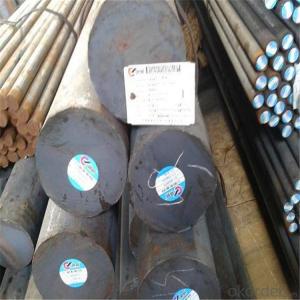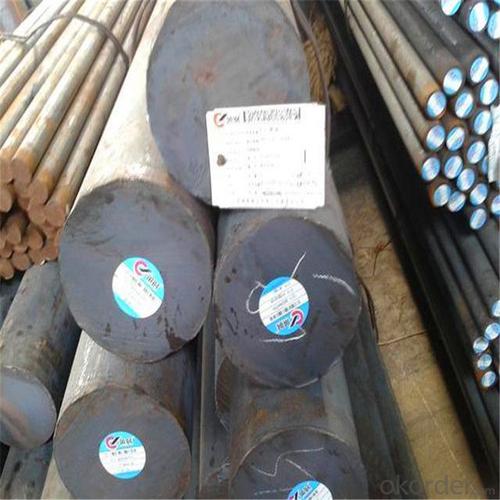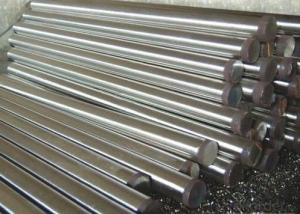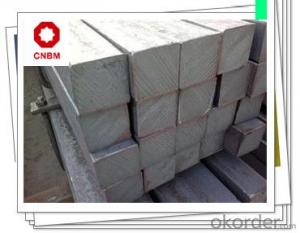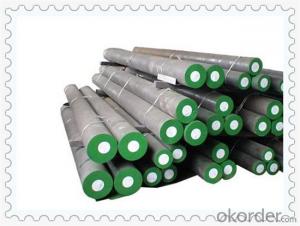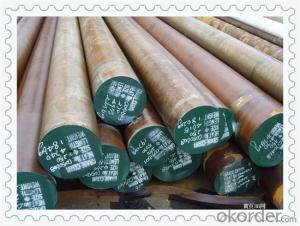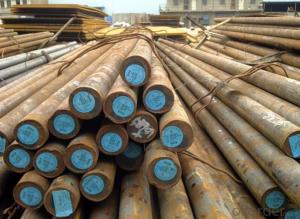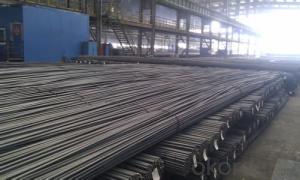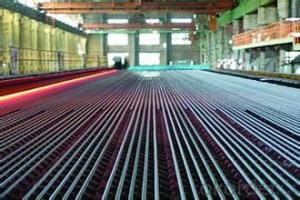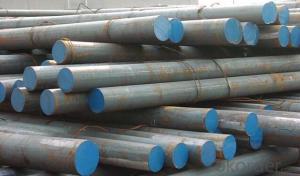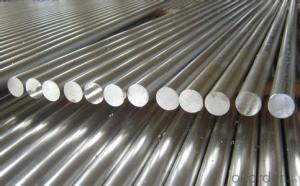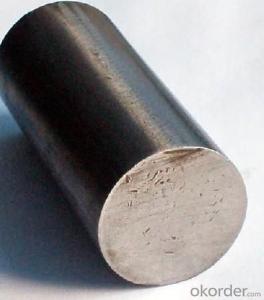ASTM A36 Round Steel Bar Large Quantity in Stock
- Loading Port:
- Tianjin
- Payment Terms:
- TT OR LC
- Min Order Qty:
- 100 m.t.
- Supply Capability:
- 500000 m.t./month
OKorder Service Pledge
OKorder Financial Service
You Might Also Like
Specification
High Quality A36 Round Steel Bar Large Quantity in Stock
Product Description of High Quality A36 Round Steel Bar Large Quantity in Stock
1. Steel grade: ASTM4140, SCM440, 42CrMo, DIN1.7225
2. Length: 6M-12M
3. Diameter: 16mm-300mm
4. Product range: round bar, flat bar, square bar
5. Technique: Hot rolled, forged, cold drawn
Specification of High Quality A36 Round Steel Bar Large Quantity in Stock
Material | SCM4140 | Round bar | Dia(mm) | 16-300mm |
Process | EAF + LF + VD + Forged + Heat Treatment (optional) | Length (mm) | Max 12m | |
Heat treatment | Normalized / Annealed / Quenched / tempered | Flat bar | Thickness(mm) | 8-500mm |
Delivery condition | Hot forged +Rough machined (black surface after Q/T)+ Turned (optional) | Width(mm) | 70-200mm | |
Test | Ultrasonic test according to SEP 1921-84 D/d | Length (mm) | Max 12m |
Chemical Composition of High Quality A36 Round Steel Bar Large Quantity in Stock
C | Si | Mn | Cr | Mo | P | S |
0.38~0.43 | 0.15~0.35 | 0.75~1.00 | 0.8~1.1 | 0.15~0.25 | ≤0.035 | <0.04< td=""> |
Photo Show of High Quality A36 Round Steel Bar Large Quantity in Stock
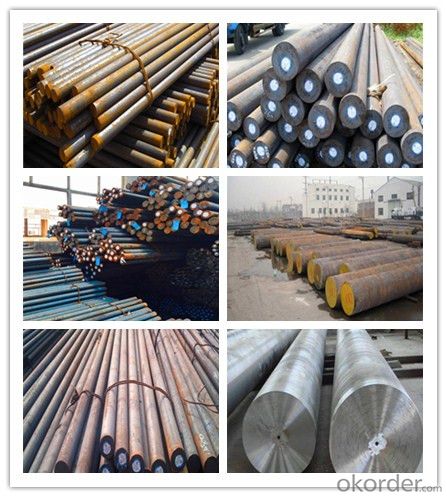
Packing and Delivery:
Packing in bundle package, or as customer's requirements.
Delivery Detail: 45 days after receiving the deposit.
Usage and Applications of High Quality A36 Round Steel Bar Large Quantity in Stock
1. Steel round bar is used in a large number of architectural and engineering structures. Or it can be used in construction of plants for the production of steel house frames, high-voltage transmission towers, bridges, vehicles, boilers, containers, ships, etc.
2. And we can use this kind of product on the performance of the mechanical parts if the demand is not very high.
3. Some special material steel round bar can be used for main shaft of steamer, hummer shank, with big section and supper force.
Company Information
CNBM International Corporation is the most important trading platform of CNBM group.
Whith its advantages, CNBM International are mainly concentrate on Cement, Glass, Iron and Steel, Ceramics industries and devotes herself for supplying high qulity series of refractories as well as technical consultancies and logistics solutions.


F A Q
1, Your advantages?
professional products inquiry, products knowledge train (for agents), smooth goods delivery, excellent customer solution proposale
2, Test & Certificate?
SGS test is available, customer inspection before shipping is welcome, third party inspection is no problem
3, Factory or Trading Company?
CNBM is a trading company but we have so many protocol factories and CNBM works as a trading department of these factories. Also CNBM is the holding company of many factories.
4, Payment Terms?
30% TT as deposit and 70% before delivery.
Irrevocable L/C at sight.
5, Trading Terms?
EXW, FOB, CIF, FFR, CNF
6, After-sale Service?
CNBM provides the services and support you need for every step of our cooperation. We're the business partner you can trust.
For any problem, please kindly contact us at any your convenient time.
We'll reply you in our first priority within 24 hours.
- Q: Can steel round bars be used for making connecting rods?
- Yes, steel round bars can be used for making connecting rods. Steel is a commonly used material for connecting rods due to its high strength and durability, making it suitable for withstanding the stress and load requirements of an engine.
- Q: What is the maximum temperature that steel round bars can withstand?
- The maximum temperature a steel round bar can tolerate depends on the grade or type of steel used. In general, carbon steel can endure temperatures of up to approximately 1,482 degrees Celsius (2,700 degrees Fahrenheit) before its structural integrity starts to deteriorate. However, it is worth noting that the maximum temperature tolerance of steel can be altered by different alloying elements and manufacturing processes. For instance, stainless steel can withstand higher temperatures compared to carbon steel because of its increased resistance to oxidation and corrosion. Additionally, the duration of exposure to high temperatures must be taken into account, as prolonged heat exposure can cause the steel to soften and eventually fail. Therefore, it is crucial to refer to the manufacturer's specifications or seek professional advice to determine the maximum temperature a specific steel round bar can endure in a given application.
- Q: What is the carbon content in steel round bars?
- The carbon content in steel round bars varies depending on the grade and type of steel being used. Generally, carbon steel round bars contain carbon in the range of 0.08% to 1.5%. Higher carbon content provides increased strength and hardness, but it also decreases weldability and ductility. The specific carbon content in steel round bars is determined during the manufacturing process and can be specified by the customer based on their desired mechanical properties and application requirements.
- Q: How do steel round bars compare to aluminum round bars?
- Steel round bars are generally stronger and more durable than aluminum round bars. They have a higher tensile strength, making them suitable for heavy-duty applications that require high levels of strength and resistance to bending or deformation. Aluminum round bars, on the other hand, are lighter and more corrosion-resistant, making them ideal for applications that prioritize weight reduction and resistance to exposure to harsh environments. The choice between steel and aluminum round bars ultimately depends on the specific requirements of the application.
- Q: How do you calculate the weight of a steel round bar based on its length and diameter?
- The weight of a steel round bar can be determined by utilizing the subsequent equation: Weight = (π/4) x (Diameter^2) x Length x Density. In this equation, π denotes the mathematical constant pi, with an approximate value of 3.14159. Diameter represents the measurement across the widest point of the steel round bar, while Length corresponds to the overall length of the bar. Additionally, Density signifies the typical density of steel, which is approximately 7850 kilograms per cubic meter. To calculate the weight, first square the diameter and then proceed to multiply it by the length and density. Finally, multiply the outcome by π/4 to obtain the weight of the steel round bar in the desired units, typically kilograms or pounds. It is crucial to acknowledge that this equation assumes the steel round bar is a solid cylinder with a uniform diameter. If there are any variations or irregularities present in the bar, the weight determined using this equation may not be entirely accurate.
- Q: How are steel round bars used in the manufacturing of mining equipment?
- Steel round bars are an essential component in the manufacturing of mining equipment due to their strength, durability, and versatility. These bars are used in various applications throughout the mining industry, ensuring the reliability and longevity of the equipment. One of the primary uses of steel round bars in mining equipment is for the construction of frames and structural components. The bars provide the necessary structural support, ensuring the overall stability and robustness of the equipment. Whether it is for excavators, drilling rigs, or conveyor systems, steel round bars play a crucial role in maintaining the integrity of the machinery. Moreover, steel round bars are commonly utilized in the manufacturing of mining tools and attachments. These bars can be machined and shaped into different forms, such as shafts, pins, and bolts, which are vital for various mining operations. For example, drill bits used for drilling into rock formations are often made with steel round bars due to their ability to withstand high-pressure conditions. In addition, steel round bars are essential for the fabrication of wear-resistant components in mining equipment. The harsh environments in mining, including abrasive materials and extreme temperatures, necessitate the use of durable materials. Steel round bars with specific alloys and heat treatments can be employed to create wear-resistant parts like cutting edges, teeth, and buckets for excavators, ensuring their longevity and performance. Furthermore, steel round bars are also utilized in the production of support structures and safety features in mining equipment. These bars can be used to create roll cages, protective frames, and guardrails, providing a safe working environment for operators and minimizing the risk of accidents. Overall, steel round bars are a vital component in the manufacturing of mining equipment, contributing to their strength, reliability, and performance. Their use in construction, tool fabrication, wear-resistant components, and safety features ensures the durability and efficiency of mining machinery, enabling the industry to operate effectively and safely.
- Q: Can steel round bars be used for making automotive suspension systems?
- Automotive suspension systems can indeed be made using steel round bars. These bars possess numerous advantages that render them suitable for this purpose. Primarily, steel is renowned for its exceptional strength and durability, two crucial characteristics for suspension components that must endure heavy loads and constant vibrations. Moreover, steel round bars offer superior stiffness and rigidity, allowing them to maintain the desired shape and functionality in diverse driving conditions. Additionally, steel is widely accessible and cost-effective, making it a favored option among automotive manufacturers. Furthermore, steel round bars can be easily machined and shaped into intricate forms, facilitating the production of suspension components with precise dimensions and specifications. In conclusion, steel round bars represent a dependable and pragmatic material for crafting automotive suspension systems.
- Q: What are the different types of steel round bar alloys used in the automotive industry?
- In the automotive industry, some of the commonly used steel round bar alloys include carbon steel, alloy steel, stainless steel, and tool steel. Carbon steel is widely used due to its affordability and high strength. Alloy steel, on the other hand, is known for its enhanced mechanical properties and resistance to wear and tear. Stainless steel is popular for its corrosion resistance, making it suitable for parts exposed to harsh environments. Lastly, tool steel is utilized for its exceptional hardness and ability to withstand high temperatures, often used in the production of cutting and shaping tools for automotive manufacturing.
- Q: What is the difference between hot rolled and cold rolled steel round bars?
- The main difference between hot rolled and cold rolled steel round bars lies in the process of production. Hot rolled steel round bars are formed by heating the steel above its recrystallization temperature and then rolling it into the desired shape. This process makes the steel more malleable and ductile, resulting in a rougher surface finish. On the other hand, cold rolled steel round bars are formed by rolling the steel at room temperature. This process produces a smoother surface finish and tighter dimensional tolerances, but it also makes the steel less malleable. Overall, the choice between hot rolled and cold rolled steel round bars depends on the specific application and desired characteristics of the end product.
- Q: Can steel round bars be plated or coated?
- Steel round bars can undergo plating or coating, which is a widely employed technique to enhance their appearance, durability, and resistance to corrosion. During this process, a layer of a different material is applied to the surface of the steel round bars using methods like electroplating, hot-dip galvanizing, powder coating, or painting. The choice of plating or coating material depends on the specific requirements and desired properties of the steel round bars. For instance, zinc plating is often used to provide corrosion resistance, while chrome plating can enhance their aesthetic appeal. In summary, plating or coating steel round bars can significantly enhance their performance and prolong their lifespan.
Send your message to us
ASTM A36 Round Steel Bar Large Quantity in Stock
- Loading Port:
- Tianjin
- Payment Terms:
- TT OR LC
- Min Order Qty:
- 100 m.t.
- Supply Capability:
- 500000 m.t./month
OKorder Service Pledge
OKorder Financial Service
Similar products
Hot products
Hot Searches
Related keywords
